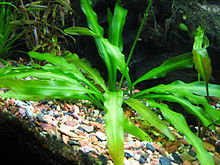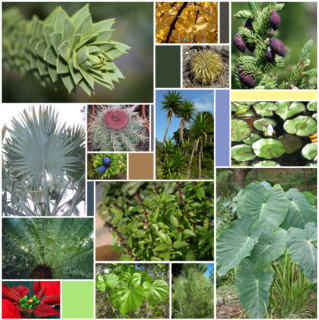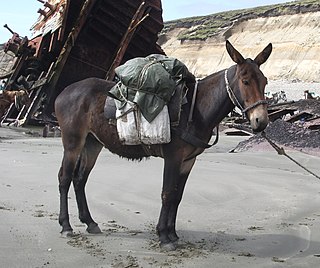
Chaenomeles is a genus of three species of deciduous spiny shrubs, usually 1–3 m tall, in the family Rosaceae. They are native to Japan, Korea, China, Bhutan, and Burma. These plants are related to the quince and the Chinese quince, differing in the serrated leaves that lack fuzz, and in the flowers, borne in clusters, having deciduous sepals and styles that are connate at the base.
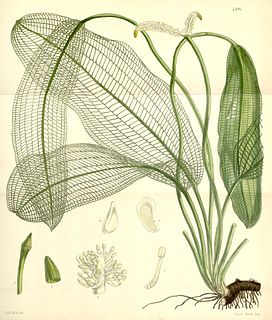
Aponogeton madagascariensis is commonly known as Madagascar laceleaf, lattice leaf or lace plant. It is an aquatic plant native to Madagascar, popularly sold for use in aquariums. It is endangered in the wild.

Anubias is a genus of aquatic and semi-aquatic flowering plants in the family Araceae, native to tropical central and western Africa. They primarily grow in rivers and streams, but can also be found in marshes. They are characterized by broad, thick, dark leaves that come in many different forms. The genus was revised in 1979 and since then its nomenclature has been stable. Species can be determined by using mostly characteristics of the inflorescence. Because of the often shady places where the plants grow, the genus was named after the Egyptian god Anubis, the god of the afterlife. The genus was first described in 1857 by Heinrich Wilhelm Schott, with A. afzelii as its type species.

The Aponogetonaceae are a family of flowering plants in the order Alismatales. The Aponogetonaceae is considered to be allied to the Potamogetonaceae - Najadaceae complex of families.

Echinodorus cordifolius, the spade-leaf sword or creeping burhead, is a species of aquatic plants in the Alismatales. It is native to Mexico, the West Indies, Central America, South America and the southeastern United States.

Aponogeton distachyos or Aponogeton distachyum, also known as waterblommetjie, Cape-pondweed, water hawthorn, vleikos and Cape pond weed is an aquatic flowering plant.

Echinodorus macrophyllus is a species of aquatic plants in the Alismataceae. It is native to Brazil and Bolivia.
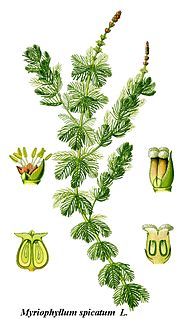
Myriophyllum spicatum is native to Europe, Asia, and north Africa, but has a wide geographic and climatic distribution among some 57 countries, extending from northern Canada to South Africa. It is a submerged aquatic plant, grows in still or slow-moving water, and is considered to be a highly invasive species.

Iris giganticaerulea is a species of iris, it is also in the subgenus of Limniris and in the Series Hexagonae. It is a rhizomatous perennial, from northern America. It has long bright green leaves, very tall stems, 1–2 musky fragrant flowers, in a range of blue shades, from pale blue, to lavender blue, to bright blue, to dark blue, and to violet blue. Rarely, there is a white form.
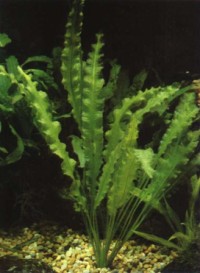
Aponogeton crispus is an aquatic plant species.

Aponogeton ulvaceus is a submerged aquatic plant with a small cone shaped, slightly hairy rhizome about 1.18 inches (30mm) in diameter. The leaf blades have a base that tapers gradually, pale green in colour, 20+ inches long and 3 inches (8 cm) broad, with a wavy margin on petioles of an equal length, and in appearance slightly translucent. A single bulb may produce up to forty leaves in good conditions. No floating leaves are formed.
Aponogeton longiplumulosus is a submerged aquatic plant that is native to Madagascar. It possesses an elongated rhizome 2–3 cm in diameter. The leaves are an olive green-brown, 8 - 14 inches (20–35 cm) long and 2.5 inches (6 cm) broad, with a fluted margin and a petiole up to about 24 inches (60 cm) long. No floating leaves are formed. New leaf colour forms have been introduced recently. The flowers are a dark violet in colour.
Cryptocoryne affinis is a plant species belonging to the Araceae genus Cryptocoryne.
Aponogeton rigidifolius is a species of freshwater plant native to Sri Lanka. In the wild it grows in deep water at temperatures of 68 to 77 °F in sandy soil with the water pH at 7.2.

Nymphaea nouchali, often known by its synonym Nymphaea stellata, or by common names blue lotus, star lotus, red and blue water lily, blue star water lily or manel flower is a water lily of genus Nymphaea. It is native to southern and eastern parts of Asia, and is the national flower of Sri Lanka and Bangladesh. This species is sometimes considered to include the blue Egyptian lotus Nymphaea caerulea. In the past, taxonomic confusion has occurred, with the name Nymphaea nouchali incorrectly applied to Nymphaea pubescens.

Aponogeton bernerianus is an aquatic plant from eastern Madagascar. It has a 3 cm thick tuber or thick and branchy rhizome. Leaf blade up to 13 cm petiolate, strap-shaped, highly bullate and undulate, up to 50(-120) cm long and 1.5-6.5(-10) cm wide, dark green coloration. Peduncle up to 75 cm long, tapering towards the inflorescence. Spathe up to 15 mm long, caducous. Inflorescence with 3-15 up to 8-cm long spikes with omnilateral flowers; 2(3) white tepals; 6 stamens; 3(4) carpels with 2 ovules each. Fruit about 10 x 7 mm. Seed about 7x4 mm in size, simple testa.

Aponogeton capuronii is an aquatic plant found in southeastern Madagascar.
Aponogeton abyssinicus is an amphibious plant found in East Africa, from Ethiopia to Malawi and Zaire. Root stock tuberous or oblong, up to 2.5 cm diameter. Submersed leaves initially strap-shaped, up to 12 cm long and 6 mm wide, continuing lanceolate to obovate, up to 8.5 cm long, 2.6 cm wide and up to 10 cm long petiolate. Blade thin and slightly transparent, with a narrowing or decurrent base and acute or obtuse apex. Adults floating, up to 50 cm long petiolate. Floating leaf blade linear to ovoid, rarely cordate, up to 16 cm long and 5 cm wide, usually considerably smaller. Emersed leaves shaped like the floating leaves, slightly leathery and shorter petiolate. Peduncle up to 45 cm long, angled, dark red to green coloration, slightly pubescent underwater, almost glabrous above water, not swollen under the inflorescence. Spathe 1.0-1.6 cm long, caducous. Inflorescence featuring two 1.5-5-cm long spikes with omni-lateral flowers; 2 tepals, violet or white coloration; 6 stamens ; 3 carpels. Fruit up to 7 x 2.75 mm large, with (4-) 7-10 seeds, sized 1-2 x 0.75 mm, double testa.

Limnobium laevigatum is a floating aquatic plant, and is a member of the family Hydrocharitaceae. Common names include West Indian spongeplant, South American spongeplant and Amazon or smooth frogbit. This plant was introduced to North American waterways through use in aquariums and aquascapes.
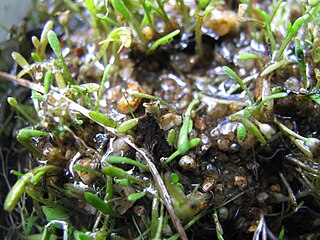
Glossostigma cleistanthum, also known as mudmat, is a freshwater aquatic plant native to Australia, New Zealand, India and East Africa. It is a cleistogamous plant, which is a type of self-pollinating plant that can propagate using non-opening flowers. Where growth is submerged, the leaves are between 0.5–2.5 inches long and bear closed, self-pollinating flowers. These leaves are nearly sessile and grow along the stem in alternating pairs that resemble rabbit ears. Where water recedes and growth is emergent, the leaves are much smaller, ranging between 0.2–0.5 inches in length. The emergent plants produce insect-pollinated flowers located on short stalks. It belongs to the family Phrymaceae which includes annuals and perennials.
